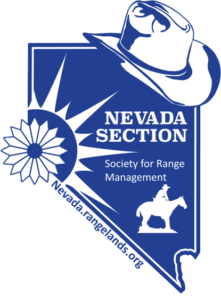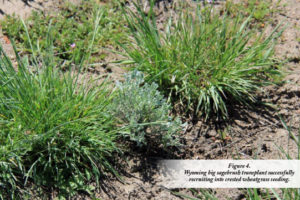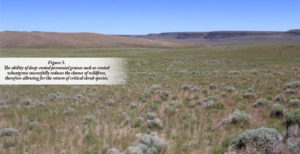Wyoming big sagebrush (Artemisia tridentata subsp. Wyomingensis) is a dominant shrub species on millions of acres of rangelands throughout the Intermountain West and plays a critical role in the health and diversity of many wildlife species such as sage grouse and mule deer. The accidental introduction and subsequent invasion of cheatgrass (Bromus tectorum) throughout the Intermountain West has truncated secondary succession by providing a fine-textured, early maturing fuel that increases the chance, rate, spread and season of wildfires. Big sagebrush communities that historically burned every 60-110 years are now burning as frequently as every 5-10 years, simply too short of a period of time to allow for the return of this critical shrub species. When cheatgrass moves in, wildfires that destroy many shrubs follow. This scenario has played out all macros in the Intermountain West.
 With each passing wildfire season, more and more shrub habitats are converted to cheatgrass dominance (Figure 1 at left, click on image to see larger). The loss of shrubs has important consequences to wildlife, especially fragmentation of habitat to sensitive species such as sage grouse and wintering mule deer herds, and resource managers often point out their frustration of lack of shrub species in crested wheatgrass seedings.
With each passing wildfire season, more and more shrub habitats are converted to cheatgrass dominance (Figure 1 at left, click on image to see larger). The loss of shrubs has important consequences to wildlife, especially fragmentation of habitat to sensitive species such as sage grouse and wintering mule deer herds, and resource managers often point out their frustration of lack of shrub species in crested wheatgrass seedings.
Natural recruitment of Wyoming big sagebrush is well reported, yet the natural recruitment of Wyoming big sagebrush following wildfire is very limited. Wyoming big sagebrush does not re-sprout following wildfires, it does not build persistent seed banks and it does not have an active wind or granivore dispersal system with the vast majority of seed being dispersed within a meter of the shrub. Restoration practices to re-establish Wyoming big sagebrush has largely been met with sub-marginal success, yet the need to restore or rehabilitate Wyoming big sagebrush has become increasingly important due to extensive losses of sagebrush habitats following the more frequent large catastrophic wildfires.
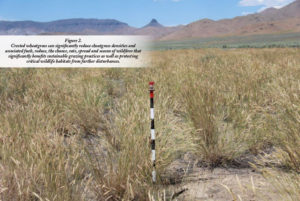 The establishment of deep-rooted, long-lived perennial grasses is the best-known method at suppressing cheatgrass. The introduced crested wheatgrass (Agropyron cristatum) was in initially seeded on a million plus acres in Nevada to provide much needed forage for over grazed rangelands, but was soon recognized to successfully compete with cheatgrass in arid environments as well as competitively suppress cheatgrass and associated fuels (Figure 2 at left, click on image to see larger).
The establishment of deep-rooted, long-lived perennial grasses is the best-known method at suppressing cheatgrass. The introduced crested wheatgrass (Agropyron cristatum) was in initially seeded on a million plus acres in Nevada to provide much needed forage for over grazed rangelands, but was soon recognized to successfully compete with cheatgrass in arid environments as well as competitively suppress cheatgrass and associated fuels (Figure 2 at left, click on image to see larger).
Even though over 1 million acres of Nevada rangelands was seeded to crested wheatgrass, many of those seedings have since returned to shrub dominance to a point where the shrub densities have significantly reduced crested wheatgrass densities and opened the door to increased cheatgrass occurrence in those communities. Even with older crested wheatgrass seedings being increasingly brushed up, there is an increasing demand to diversify more recent crested wheatgrass seedings with desirable species such as big sagebrush.
Neil West, retired range Scientist at Utah State University pointed out more than two decades ago that it is important to understand site potential before jumping to conclusions on the length of time that species such as crested wheatgrass would remain dominant on a site. Dr. West pointed out that crested wheatgrass seeded on sites that are represented by the dominance of herbaceous species are more likely to remain crested dominant for some time just as bluebunch wheatgrass would remain the dominant herbaceous species.
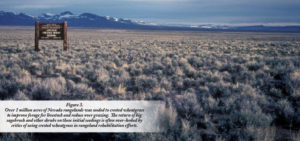 On sites that are more shrub dominated such as western and central Nevada, the crested wheatgrass plants would become shrub dominated due to lack of fire and other disturbances (Figure 3 at left, click on image to see larger).
On sites that are more shrub dominated such as western and central Nevada, the crested wheatgrass plants would become shrub dominated due to lack of fire and other disturbances (Figure 3 at left, click on image to see larger).
Seeding Wyoming big sagebrush in existing crested wheatgrass seedings has been reported to be largely unsuccessful, therefore transplanting of big sagebrush has become more popular. Most big sagebrush transplanting research has been conducted in Utah where warm-season precipitation is more prevalent and therefore spring-time transplanting efforts are recommended (Stevens 2004). More recent data from northern Nevada reported from 2-40% success during spring Wyoming big sagebrush transplanting efforts (McAdoo et. al 2013). In the cold desert of the Great Basin summer precipitation is very limiting, therefore, we designed an experiment to test the success of big sagebrush seedlings transplanted in existing crested wheatgrass seedings in the spring (March) compared to the fall (November) of the year.
Methods
We selected two sites in northern Nevada to test the survivability of transplanted Wyoming big sagebrush seedlings in established crested wheatgrass seedings.
The first site, Peterson, is located about 25 miles northwest of Reno, Nevada and is a crested wheatgrass seeding from a 1973 wildfire. The site is at an elevation of 4,600’ and is dominated by crested wheatgrass with sparse overstory of Wyoming big sagebrush. The site is very diverse and also includes bottlebrush squirreltail (Elymus elymoides), bluegrass (Poa secunda), desert needlegrass (Achnatherum speciosum), Great Basin wildrye (Leymus cinereus), creeping wildrye (Leymus triticoides), Indian ricegrass (Achnatherum hymenoides), cheatgrass, Green Ephedra (Ephedra viridis) antelope bitterbrush (Purshia tridentata), green rabbitbrush (Chrysothamnus viscidiflorus), desert peach (Prunus andersonii), and filaree (Erodium cicutarium). The soil is a fine-loamy, mixed course granitic and the site averages just over 10” of annual precipitation recorded from a nearby active rain gauge.
The second site, Dry Valley, is located 55 miles north of Reno, Nevada and is a crested wheatgrass seeding from a 1985 wildfire. The site is at an elevation of 4,100’ and is dominated with an understory of crested wheatgrass with a minor component of cheatgrass and a sparse overstory of Wyoming big sagebrush. The soil is a coarse-silty loam and the site receives an average 6” of annual precipitation as recorded from a nearby active rain gauge.
Commercially purchased Wyoming big sagebrush seed was sown into 1-quart size pots filled with a top soil/potting soil mix. Seedlings were grown out in a greenhouse environment for 6 months and then placed outside for one month prior to transplanting. Transplanting occurred at each site during the third week of March (spring) and November (fall).
Four blocks, 3’ centers of 25 sagebrush seedlings were transplanted into pre-dug holes, back-filled and given 1.10 gallons of water at the time of transplanting. Water was poured into the holes just prior to planting transplants to ensure moist root to soil contact. Transplant survivability was recorded monthly for 2-years.
Results and Discussion
Transplanted Wyoming big sagebrush experienced the highest success, 62%, in the fall transplanting efforts at the Peterson site, while the lowest transplanting success was recorded at the Dry valley site in the spring transplanting plots, 13%. The Peterson site recorded a 43% success when transplanted in the spring, nearly a 20% decrease from fall. The fall transplants at the Dry Valley site recorded 38% success. The Peterson study site received 10.9” of precipitation, while the Dry Valley site only received 5.6”., both within the long-term average for each site. Precipitation at these sites is more prevalent in the fall winter months (October-March), 5.3” than spring and summer months (April-September), 1.1”, which we believe contributes to the significantly higher success of Wyoming big sagebrush transplants in crested wheatgrass seedings in fall compared to spring transplanting efforts experienced in northwestern Nevada. We also measured predation, which was more of a factor at the Dry Valley site, with a high of 27% in the spring plots and a low of 7% in the Peterson fall plots.
The need for improved restoration techniques of big sagebrush continues to grow, therefore successful transplanting techniques could establish sagebrush islands and provide for long-term wildlife expansion by providing a much-needed seed source as well as improving diversity and habitat needs. By improving the success of transplanting big sagebrush seedlings through larger container sizes and proper timing, resource managers and interested parties could transplant 500 big sagebrush seedlings/acre and experience an establishment of more than 300 big sagebrush shrubs/acre, using our average fall transplanting success rates (Figure 4 above, click on image to view larger), increasing the ability of shrubs to increase stand density to critical habitats such as mule deer winter ranges or critical transitional migratory habitats. The recruitment of big sagebrush following wildfires, particularly where the understory is cheatgrass dominated, have a low probability of regenerating naturally especially in the face of increased wildfire frequencies. This is due to inadequate seed supplies on surviving plants or in the soil seed bank and the combined effects of low and erratic precipitation and herbaceous competition from exotic annuals. Since the dispersal of big sagebrush is largely limited to the mother plant the increased success of transplanting Wyoming big sagebrush increases the ability of this critical browse species to once again become a productive component of the habitat (Figure 5 above, click on image to view larger). Successfully transplanting big sagebrush into crested wheatgrass seedings should not be a big surprise, as succession of plant communities in the absence of disturbances such as wildfire over-time favors the return of shrubs even with the presence of a perennial grass.
With wildlife species populations such as greater sage grouse and mule deer performing well below desirable levels, this improvement in big sagebrush restoration technology would be very beneficial not only to sage grouse and mule deer populations but numerous other wildlife species as well. Improving the ability of resource professionals to restore Wyoming big sagebrush back into habitats that have been devastated by wildfires and other disturbances improves not only wildlife habitats, but improves ecosystem functions including nutrient cycling, soil erosion, watersheds, carbon storage in soils and plant and animal diversity.
The results of this research suggest that Wyoming big sagebrush can be successful transplanted into existing crested wheatgrass seedings and improve cover, browse and diversification of crested wheatgrass stands and not only continue to provide grazing resources, but also provide future critical habitat for wildlife.
Suggested Reading
McAdoo, K. J., C. S. Boyd, and R. L. Sheley. 2013. Site, Competition, and Plant Stock Influence Transplant Success of Wyoming Big Sagebrush. Rangeland Ecology & Management, 66(3):305-312. 2013.Stevens, R., W. L. Moden, Jr. and D. W. McKenzie. 1981. Interseeding and Transplanting Shrubs and Forbs into Grass Communities. Rangelands 3(2):55-58.
Stevens, R. 2004. Establishing plants by transplanting and interseeding. In: S. B. Monsen, R. Stevens, N. L. Shaw [Eds.]. Restoring western ranges in wildlands. Ge. Tech. Rpt. RMRS-GTR-136-vol-3. Fort Collins, CO: USDA, Forest Service, Rocky Mountain Research Station. pp. 739-744.
By Charlie D. Clements and Dan N. Harmon
nevada.rangelands.org

